Vintage Treasures: Where Do We Go From Here? edited by Isaac Asimov
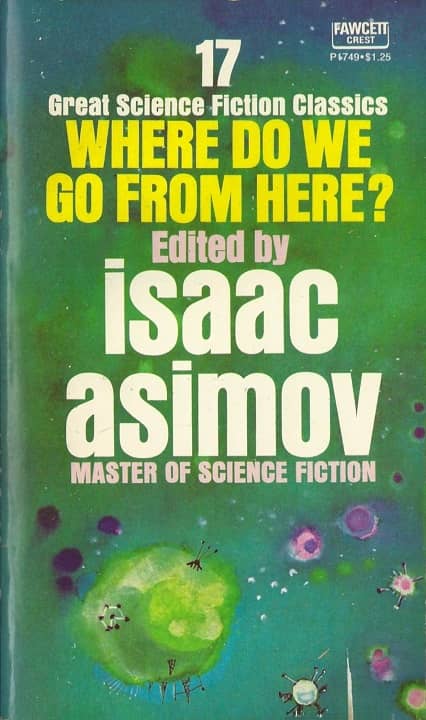 |
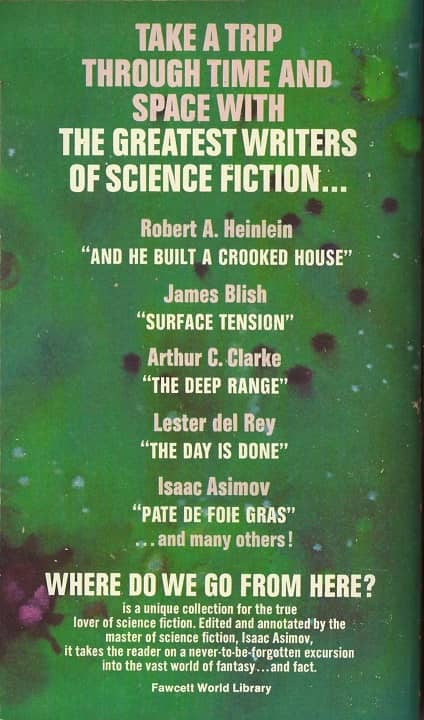 |
There are prolific anthologists, and there are very prolific anthologists, and there’s Isaac Asimov. The Internet Science Fiction database lists nearly 200 anthologies with his name on them, averaging around seven per year between 1963 and his death in 1992. (If you’re thinking, Geez that seems like a lot, let me clarify for you. Yes. It’s a lot.)
Of course, the vast majority of those were produced later in his career and in partnership with a team of editors, especially Martin H. Greenberg and Charles G. Waugh. In the early days Asimov compiled anthologies the old-fashioned way: by himself. It was the enduring, decades-long success of those books that paved the way for the massive literary-industrial complex to spring up around Asimov in the 80s and 90s. And he may have had no original anthology more successful or popular than Where Do We Go From Here?
Where Do We Go From Here? was published in hardcover by Doubleday in 1971, reprinted by Fawcett Crest in 1972, and kept in print in paperback for nearly ten years. It was one of the most popular and discussed SF anthologies of the decade, by a wide margin, and cemented Asimov’s reputation for curating — and selling — top-notch short fiction collections. It gathers stories by Stanley G. Weinbaum, John W. Campbell, Jr., Lester del Rey, Robert A. Heinlein, Hal Clement, James Blish, Jerome Bixby, Arthur C. Clarke, James E. Gunn, H. Beam Piper, Walter Tevis, Larry Niven, and others. Here’s the complete Table of Contents.
Introduction by Isaac Asimov
“A Martian Odyssey” by Stanley G. Weinbaum (Wonder Stories, July 1934)
“Night” by John W. Campbell, Jr. (Astounding Stories, October 1935)
“The Day Is Done” by Lester del Rey (Astounding Science-Fiction, May 1939)
“Heavy Planet” by Milton A. Rothman (Astounding Science-Fiction, August 1939)
“—And He Built a Crooked House—” Robert A. Heinlein (Astounding Science-Fiction, February 1941)
“Proof” by Hal Clement (Astounding Science-Fiction, June 1942)
“A Subway Named Mobius” by A. J. Deutsch (Astounding Science Fiction, December 1950)
“Surface Tension” by James Blish (Galaxy Science Fiction, August 1952)
“Country Doctor” by William Morrison (Star Science Fiction Stories, 1953)
“The Holes Around Mars” by Jerome Bixby (Galaxy Science Fiction, January 1954)
“The Deep Range” by Arthur C. Clarke (Star Science Fiction Stories No. 3, 1955)
“The Cave of Night” by James E. Gunn (Galaxy Science Fiction, February 1955)
“Dust Rag” by Hal Clement (Astounding Science Fiction, September 1956)
“Pâté de Foie Gras” by Isaac Asimov (Astounding Science Fiction, September 1956)
“Omnilingual” by H. Beam Piper (Astounding Science Fiction, February 1957)
“The Big Bounce” Walter Tevis (Galaxy Science Fiction, February 1958)
“Neutron Star” by Larry Niven (If, October 1966)
Perhaps most interesting to fans, Asimov seemed intent in creating a book that was useful as a textbook, and so he followed up the stories with some lively discussion on each — including classroom questions.
[Click the images to find out where we go from here.]
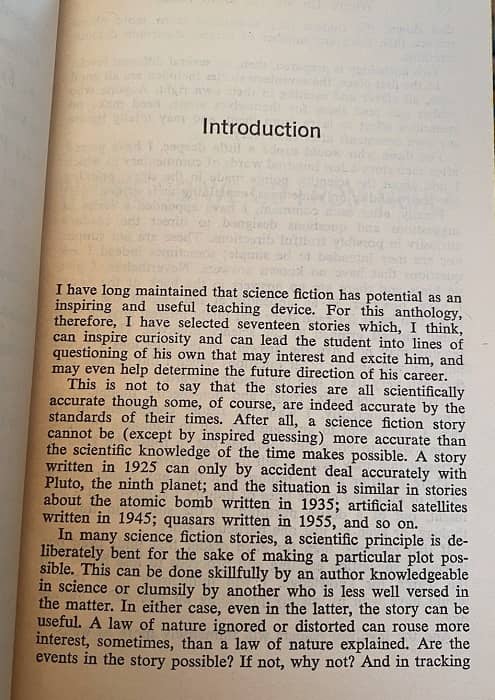 |
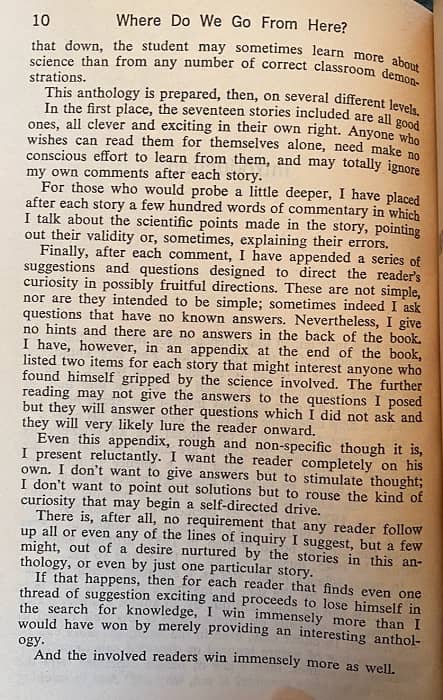 |
Asimov’s introduction for Where Do We Go From Here?
Here’s an excerpt from Asimov’s introduction:
I have long maintained that science fiction has potential as an inspiring and useful teaching device. For this anthology, therefore, I have selected seventeen stories which, I think, can inspire curiosity and can lead the student into lines of questioning of his own that may interest and excite him, and may even help determine the future direction of his career…
This anthology is prepared, then, on several different levels.
In the first place, the seventeen stories included are all good ones, all clever and exciting in their own right. Anyone who wishes can read them for themselves alone, need make no conscious effort to learn from them, and may totally ignore my own comments after each story.
For those who would probe a little deeper, I have placed after each story a few hundred words of commentary in which I talk about the scientific points made in the story, pointing out their validity or, sometimes, explaining their errors.
Finally, after each comment, I have appended a series of suggestions and questions designed to direct the reader’s curiosity in possibly fruitful directions. These are not simple, nor are they intended to be simple; sometimes indeed I ask questions that have no known answers. Nevertheless, I give no hints and there are no answers in the back of the book. I have, however, in an appendix at the end of the book, listed two items for each story that might interest anyone who found himself gripped by the science involved.
Two things strike me today, a good 40+ years after I first read this book.
- Asimov’s casually sexist language stands out like a sore thumb. I can’t read sentences like “lines of questioning of his own that may interest and excite him, and may even help determine the future direction of his career” without wincing, and I anticipate modern readers may find an entire book written like this difficult to suffer through. (I can guarantee my daughter wouldn’t put up with it.) And I can’t blame them.
- Asimov wears his science fictional bias openly. For him, SF is the highest form of writing because it blends the pleasures of literature with scientific rigor, educating readers as it entertains. I’m not sure that was ever really true (it sure wasn’t during the 30s, when pulp science fiction reined supreme), but even if it was, it ain’t true today. The moment Star Wars defined science fiction for an entire generation, helping catapult the field into broad acceptance and the era of the science fiction blockbuster, SF ceased having to justify itself as educating anybody. And thank God for that.
There are plenty of folks who still feel the same way Asimov did, or lament the fact that ‘hard’ science fiction — once considered the heart of the field — has nearly gone the way of the dinosaur. But as hard SF died away, science fiction rapidly became more accepted and popular, and that’s not an accident.
Still, science fiction remains a potent force (as Asimov emphasizes in the first paragraph of his introduction) in firing an interest in science, and inspiring careers. And that’s a large part of the reason the genre is more lively, rich and essential than ever before.
I was curious to read Asimov’s comments on the texts. Here’s his 2.5-page commentary on “A Martian Odyssey,” which he has described elsewhere as one of his favorite stories, and a tale that “had the effect on the field of an exploding grenade. With this single story, Weinbaum was instantly recognized as the world’s best living science fiction writer, and at once almost every writer in the field tried to imitate him.”
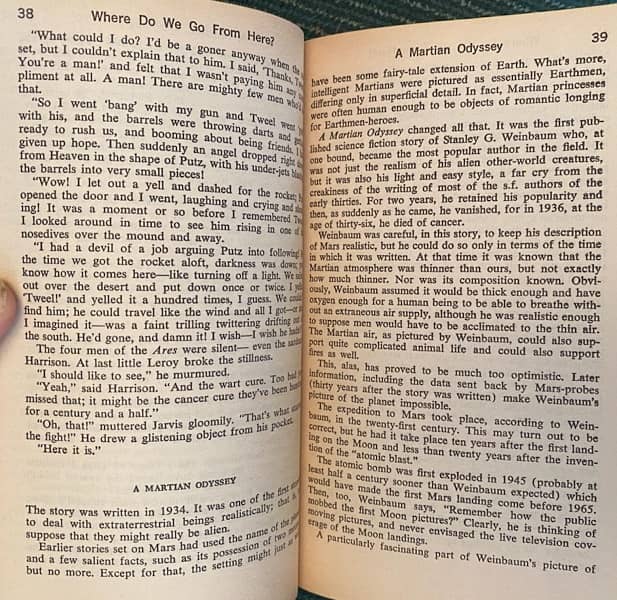 |
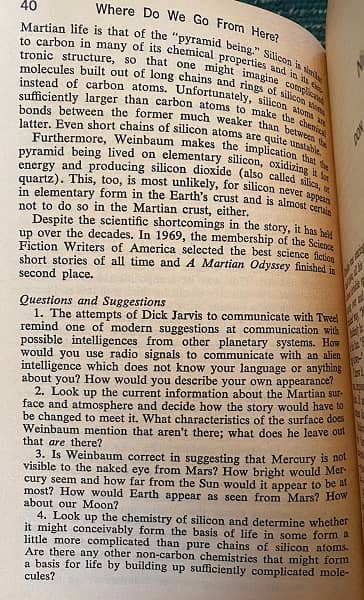 |
Asimov’s story notes and suggested questions for “A Martian Odyssey”
Where Do We Go From Here is still read and enjoyed today. John H. Jenkins at AsimovReviews.net writes
I am enormously fond of this anthology. The fact that I bought it a year or two after it came out and read it and reread it avidly perhaps half a dozen times before I could drive doesn’t hurt — but the fact is that this is a fairly unique anthology. The stories, for one thing, are generally very good — but it’s also the use Asimov has made of the stories. This book is intended to be a science teaching tool; the goal here is to illustrate Asimov’s dictum that good sf makes for good scientists by stimulating curiosity about nature. Even if the science is wrong, finding out why it’s wrong can be a lot of fun. To prove this, Asimov has appended to each story some scientific commentary and a series of questions intended to guide the reader into exploring a key idea of science found in the tale.
As for the stories themselves, I have few objections. Asimov includes his own “Pâté de Foie Gras,” which is among my very favorites. There’s also Heinlein’s delightful “And He Built a Crooked House” and A.J. Deutsch’s equally funny “Subway Named Mobius” (two math stories in the same book, wow!)… there are enough stories in here that are among my favorite reading in all of sf to make this anthology more than worth getting…
It enjoys a strong 3.96 rating on Goodreads. Here’s an excerpt from Stephen‘s 5-star review at Goodreads.
Where Do We Go From Here, a short-story collection assembled by Isaac Asimov, is more than the usual collection of short stories… Asimov believed that good science fiction must have within it good science. The stories come from a variety of authors. A few are well-known names — Lester del Rey, Robert Heinlein, Arthur C. Clarke — but most were new to me….
Only one story ([Hal Clement’s] “Proof”) escaped me completely. I was able to enjoy all of the others to varying degrees. The stories seem deliberately chosen to cover the full range of scientific knowledge: in [H. Beam Piper’s] “Omnilingual”, the readers join a team of scientists on the surface of Mars as they attempt to learn about a long-dead Martian civilization. This particular chapter concerns language. In [Clement’s] “Dust Rag”, two men on the surface of the Moon encounter problems with electromagnetism in that their visors become charged and attract lunar dust that is being charged by the Sun. The result is that the visors and the outside of their suits (including air filters) become covered in lunar dust and the astronauts — in bulky space suits — have to figure out how to return to their camp or shuttle before they run out of air. In [del Rey’s] “The Day is Done,” we see speculations on human-Neanderthal interaction… One of my favorite stories was {James Blish’s] “Surface Tension,” which shows the results of humans modifying the human genome for life on other planets. The particular planet that the story is set on is covered in water and the largest animals are crayfish, so the humans are designed to be microscopic and interact with amoebas and so forth in a story that is completely implausible but very interesting.
I found the book to be tremendously enjoyable: the stories as well as the questions Asimov probed. I wonder if he did any other projects like this. It seems like a good resource for parents with older children or teenagers who want to shape their minds to think scientifically.
Where Do We Go From Here is still widely available used. eBay currently has over 40 listings, many priced at less than the cost of a new paperback. As far as I can determine there is no digital edition.
See all our Vintage Treasures here.
I tried to buy a copy of this anthology when I first joined the Science Fiction Book Club way back in [REDACTED], but it had gone out of print. I grabbed a hardcover copy at a Friends of the Library sale a couple of years ago. I was leafing through it just the other day.
I do think it was this book — along with THE HUGO WINNERS and BEFORE THE GOLDEN AGE — that proved that Asimov’s name on an anthology meant a top seller. Asimov and his partners were to exploit that formula to good effect for the next two decades.
THE HUGO WINNERS I was able to buy as part of my introductory SFBA package, and I picked up BEFORE THE GOLDEN AGE in a second hand shop about a year later. So when DAW’s ISAAC ASIMOV PRESENTS THE GREAT SF series came along a year or two later, I snatched them up as soon as I saw them (paying for them, of course) along many other Asimov anthologies. Now that I think about it, I need to fill in some gaps in those collections.
That should be SFBC. Need more coffee.
I got both THE HUGO WINNERS and BEFORE THE GOLDEN AGE as part of my introductory offer for the Science Fiction Book Club when I was 12. The third book was THE FOUNDATION TRILOGY. I learned pretty quickly that the name Isaac Asimov was synonymous with science fiction.
The 70s and 80s were surely the Golden Age of paperback anthologies. Twenty years later, they were vanished from bookstore shelves. For many years I’ve assumed that the market has just moved on, but recently I’ve been wondering if it wasn’t the market that changed — it was the absence of people whose name could sell an anthology.
When Asimov and Harry Greenberg died, the creative engine generating so many successful anthologies died as well. Maybe I’ve been wrong all these years. Maybe it wasn’t the market that changed, it was the people.
Is it possible that if Asimov, Greenberg, Terry Carr, Don Wollheim and Gardner Dozois were still alive, we’d still have a thriving SF anthology field? Sometimes I think the answer is Yes.
My third book was THE FOUNDATION TRILOGY, as well. Great minds read alike.
I remember getting this out of the library very early in my SF reading life — I was probably 12. I think “Omnilingual” was the story that struck me most back then.
And, yeah, by then the name Asimov as editor was undoubtedly the reason it stuck out to me on the library shelf.
Is there anybody today with the brand name recognition (and guaranteed sales pull) of Isaac Asimov? George R.R. Martin, maybe?
As I note in my response to Keith West above, Asimov traded on the value of his brand name to launch multiple successful anthology series, some of which rans a decade or longer, like THE GREAT SCIENCE FICTION STORIES (25 volumes in 23 years), ASIMOV’S WONDERFUL WORLDS OF SCIENCE FICTION (10 volumes in 8 years), and ISAAC ASIMOV’S MAGICAL WORLDS OF FANTASY (12 volumes in 9 years).
GRRM and Gardner Dozois did the same thing with Martin’s name, launching a line of prestige anthologies (WARRIORS, ROGUES< OLD MARS, OLD VENUS, etc.), some of which hit bestseller lists. Maybe all that's lacking to resurrect the original science fiction anthology is another Asimov-scale big name to bring some brand name recognition?
I’m inclined to agree with you, John. Jonathon Strahan puts together some pretty impressive anthologies. Maybe he’ll fill that niche.